Cine Indígena
Slavena Mincheva
“Video Indígena” or “Cine Indígena” started as a project of people which are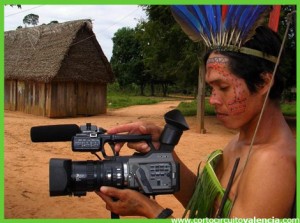
developing films and videos dealing with migration between Mexico and the United States.
Since 2006 there have been a growing number of films screened at the International Festival of Indigenous Peoples Film and Video. The project expanded and linked with filmmakers across the continent. Nowadays Cíne Indigena constitutes a transnational network of places of production and consumption.
Changing Perspectives
These films are presenting a completely new perspective of the way of life of indigenous people in Latin America. They are also in contrast with the film representations of television and mainstream cinema.
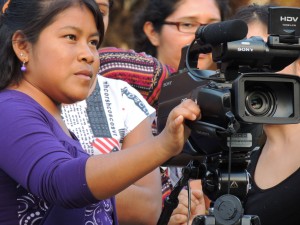
The actors of these documentaries are involved in two localities themselves, often living a translocal life. As the filmmakers’ biographies are evidence of the migratory movement, they are creating authentic film scenes, reflecting real life. They often portray everyday life in the rural indigenous communities, its agriculture, its commerce, the preparation of local dishes, community work, fiestas, political organisation and religion.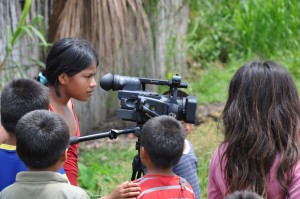
Diverse actors, among them non-indigenous collaborators and members of the anti-globalisation movement, participate in the filmmaking. For this reason Cine Indígena rather more constitutes a transnational network of places of production and consumption.
A binational context could be caused by the relocation from countryside to large city, from one country to another, or simply with the participation in different everyday and institutional settings.
Confronting Discrimination
Living among other countries they are confronting inequality and racial discrimination. They also had to face a homogesization, summerised as the group of “ethnic Mexicans”- a group which is homogenised and discriminated against within the United States. They suffered to be lumped together under a category with other populations in the context of homogenising nation models.
These homogenising nation models have been maintained and reproduced by the dominant sociaty. That means: by the community, and thereby, by the Media.
The Power of Media
At this point it is absolutely urgent to mention the power of media, especially the power of film. As a medium, which requires our basic senses, the seeing and hearing, it controls our perception of things and contexts. There are many aspects of this power:
-
the dynamic of camera work
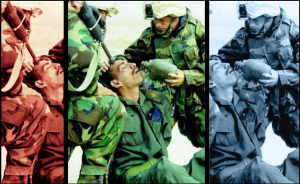
-
the point of view by filming
-
the movement of the camera as well as
-
the movements of the objects being filmed
-
the sounds being recorded
-
the choice of the colors by filming
-
the scene cutting, which is being chosen and
-
the merge of the scenes
All these important facrors dictate the presentation of the Object and are fully under the control of the person, who is filming – the cameraman.
All these tools give him the power to underline and represent already existent stereotypes and categories, as well as the power to create new perceptions and opinions.
The cameraman ist the one, who decides what, who, where, when and how to film.
Historical Summary
In the 90s indigenous persons of Mexico developed the urge to decolonize existing representations of the indigenous people as exotic, subordinate and passive “others”.
The self-identification as ‘indigenous people’ offered them the advantage of greater visibility. They do not only express a shared identity to an indigenous language group, but also in many instances, a new feeling of belonging simultaneosly to a transnational community. For this reason, they chose to appropriate and redefine the indigenous identity in their own positive terms, employing it as a political weapon.
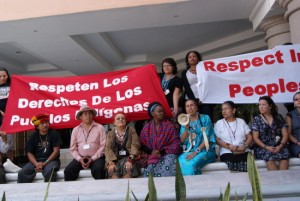
The indigenous community raised political demands on an ethnic basis and asked for collective cultural rights.
It is no coincidence that during this same period of time, indigenous people began to create their own documentaries and narrative pictures as cameramen/women, sound professionals, directors or producers. It was the start of strong indigenous movements. Local television stations and non-governmental organizations were founded.
They used the power of videotaping and started their own production of documentary and narrative films.
A new Beginning
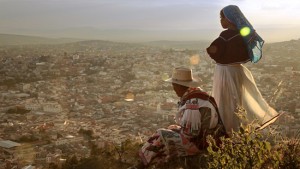
Doing their own media offered them the opportunity to
suspend the
power relation between them and the previous directors, as deputies of the dominant community, and thereby, to suspend their dependence on mainstream media.
Practicing their own camera work they are able to show their own point of view, filming the situations they interpret as interesting and important.
The media representation allowes them a greater accessibility and visibility for the world from their own perspective and understanding for themselves.
Importance of Cine Inígena
The example of Cine Indígena illustrates how creators, collaborators and viewers may construct new emotional attachments as a basis of collective feelings and belongings. This also goes along with the development of new forms of geographic and virtual mobility.
Cine Indígena made the start of collaboration work between indigenous and non-indigenous allies in Latin America. The project grows and circulates extensively and with it the sensibility of the public for the indigenous issues.
In these respects, Cine Indígena, as part of the field of popular culture and media, has now become an important public sphere for the negotiation of multiple belongings related to local community, nation and a transnational space.
Sources:
main text:
Kummels, Ingrid 2011: Cine Indígena: Video, Migration and the Dynamics of Belonging between Mexico and the USA. In: Ethnicity, Citizenship and Belonging: Practices, Theory and Spacial Dimensions. Sarah Albiez, Nelly Castro, Lara Jüssen, and Eva Youkhana, eds. Frankfurt am Main: Vervuert Verlag. 257-280.
Ginsburg, Faye 1991: Indigenous Media: Faustian Contract or Global Village? Cultural Anthropology, 6(1): 92–112.
Ginsburg, Faye 2002: Mediating Culture: Indigenous Media, Ethnographic Film, and the Production of Identity. In: Kelly Askew and Richerd R. Wilk (eds.) The Anthropology of Media. A Reader. Oxford: Blackwell. 210-235.
Photographies:
https://www.cortocircuitovalencia.com/wp-content/uploads/2009/03/cine-indigena.jpg
https://pbs.twimg.com/media/CM8gV6LXAAAkXnT.jpg
https://lascamaras2010.files.wordpress.com/2010/07/dsc_06511.jpg
https://www.yepan.cl/wp-content/uploads/2012/11/familias-taller.jpg
https://www.lareina.cl/recursos/cine_indigena.jpg
https://www.dac.org.ar/archivos/articulos/festivales_berlin_2015_el_cine_indigena_latinoamericano_es_protagonista_2.jpg
https://geo-mexico.com/wp-content/uploads/2011/07/indigenous-peoples-rights.jpg
https://www.proaraucania.com/wp-content/uploads/2014/11/nota_clacpi_foto_01_cardenas.jpg
https://i.imgur.com/y1k6qTD.png


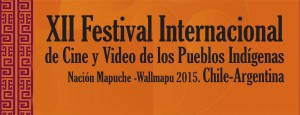

 Die
Die